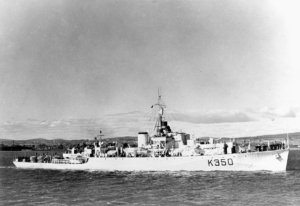OFFICIAL HISTORY OF
1st OF NAME
The “River” Class frigate, HMCS CAPE BRETON, First of Name, was laid down in the yards of the Morton Engineering and Dry Dock Company at Quebec City on 5 May 1942. She was launched on 24 November of that year and commissioned on 25 October 1943. She was named in honour of Sydney, N.S., the principal town on Cape Breton Island, but to avoid confusion with HMAS Sydney, the name of the island was used instead.
In Halifax, in February 1944, she joined Convoy HX-280 to make passage to Londonderry, Northern Ireland, to join the Sixth Escort Group. In the following month, this group was one of those chosen to support a convoy back along the perilous route from Murmansk, North Russia. Although the escort for this convoy was a large and heavy one, the enemy opened vigorous attacks against the merchant ships. They succeeded in torpedoing two of them, but at the cost of three of their number. After the first torpedoing, CAPE BRETON sighted a U-boat beyond an ice barrier and twice attacked it with hedgehog. Her movements, however, were hindered by ice and she lost contact. The next morning, she sighted another U-boat, but it too escaped.
The group also took part in the Invasion of Normandy. Along with other groups and two aircraft carriers, they engaged in Operation “CA”, which was composed of anti-submarine patrols in the entrance to the English Channel and the Bay of Biscay. Transferred to the Portsmouth Command, the group worked in the English Channel and, in September 1944, took up a patrol between the Orkneys and Faeroes to intercept U-boats on passage from German or Norwegian bases to the Atlantic cruising grounds. One of the ships of the group, HMCS ANNAN, sank U-1006 on the evening of 14 October.
Escort Group-6 returned to Londonderry on 19 October and in that port, CAPE BRETON left them and relieved HMC Frigate STONETOWN in Escort Group C-8 on passage to Halifax escorting Convoy ON-251. After a refit and “working-up” exercises in Bermuda, the ship sailed to St. John’s and, on 8 May 1945, VE-Day, left for Londonderry. In the latter stages of her voyage she met and joined Convoy HX-354. She had been ordered to join Escort Group 9 on arrival, but, with the war in Europe ended, she was ordered to turn about and sail to Vancouver via Bermuda and the Panama Canal to refit for tropical service in the war against Japan. She was, however, still at the Burrard yard, North Vancouver, on 14 August when the Japanese surrendered. She left Vancouver for Esquimalt and there landed her stores.
On 26 January 1946, the ship paid off. War Assets Corporation sold her to Wagner, Stein and Greene Co. of Victoria, which firm dismantled her and scuttled the bare hull to form part of a breakwater.

 CFB Esquimalt Naval and Military Museum
CFB Esquimalt Naval and Military Museum
 CFB Esquimalt Naval and Military Museum
CFB Esquimalt Naval and Military Museum CFB Esquimalt Naval and Military Museum
CFB Esquimalt Naval and Military Museum CFB Esquimalt Naval and Military Museum
CFB Esquimalt Naval and Military Museum CFB Esquimalt Naval and Military Museum
CFB Esquimalt Naval and Military Museum CFB Esquimalt Naval and Military Museum
CFB Esquimalt Naval and Military Museum CFB Esquimalt Naval and Military Museum
CFB Esquimalt Naval and Military Museum CFB Esquimalt Naval and Military Museum
CFB Esquimalt Naval and Military Museum CFB Esquimalt Naval and Military Museum
CFB Esquimalt Naval and Military Museum CFB Esquimalt Naval and Military Museum
CFB Esquimalt Naval and Military Museum CFB Esquimalt Naval and Military Museum
CFB Esquimalt Naval and Military Museum CFB Esquimalt Naval and Military Museum
CFB Esquimalt Naval and Military Museum
 CFB Esquimalt Naval and Military Museum
CFB Esquimalt Naval and Military Museum CFB Esquimalt Naval and Military Museum
CFB Esquimalt Naval and Military Museum CFB Esquimalt Naval and Military Museum
CFB Esquimalt Naval and Military Museum CFB Esquimalt Naval and Military Museum
CFB Esquimalt Naval and Military Museum CFB Esquimalt Naval and Military Museum
CFB Esquimalt Naval and Military Museum CFB Esquimalt Naval and Military Museum
CFB Esquimalt Naval and Military Museum CFB Esquimalt Naval and Military Museum
CFB Esquimalt Naval and Military Museum CFB Esquimalt Naval and Military Museum
CFB Esquimalt Naval and Military Museum CFB Esquimalt Naval and Military Museum
CFB Esquimalt Naval and Military Museum CFB Esquimalt Naval and Military Museum
CFB Esquimalt Naval and Military Museum

 CFB Esquimalt Naval and Military Museum
CFB Esquimalt Naval and Military Museum CFB Esquimalt Naval and Military Museum
CFB Esquimalt Naval and Military Museum CFB Esquimalt Naval and Military Museum
CFB Esquimalt Naval and Military Museum CFB Esquimalt Naval and Military Museum
CFB Esquimalt Naval and Military Museum CFB Esquimalt Naval and Military Museum
CFB Esquimalt Naval and Military Museum
 CFB Esquimalt Naval and Military Museum
CFB Esquimalt Naval and Military Museum



 CFB Esquimalt Naval and Military Museum
CFB Esquimalt Naval and Military Museum
























 CFB Esquimalt Naval and Military Museum
CFB Esquimalt Naval and Military Museum CFB Esquimalt Naval and Military Museum
CFB Esquimalt Naval and Military Museum
 CFB Esquimalt Naval and Military Museum
CFB Esquimalt Naval and Military Museum